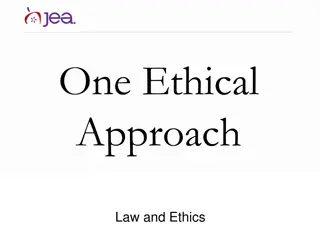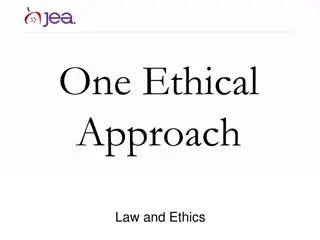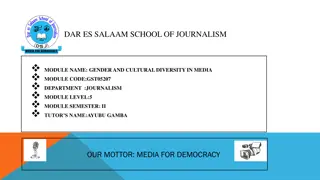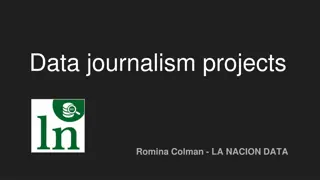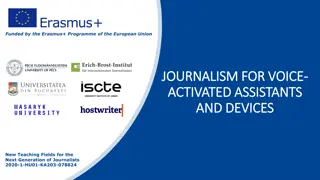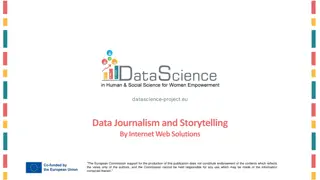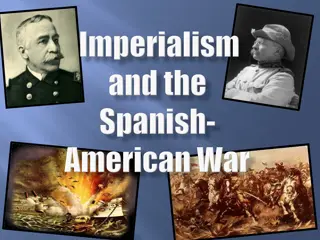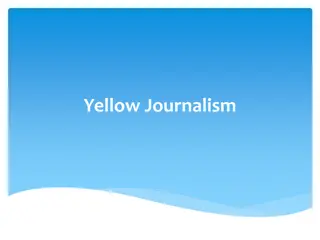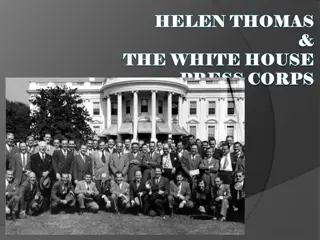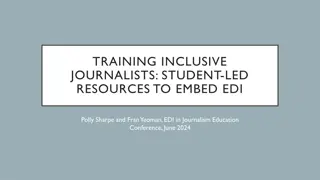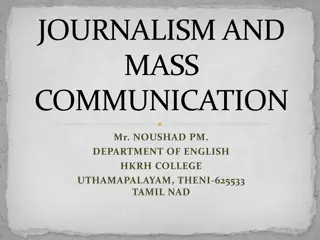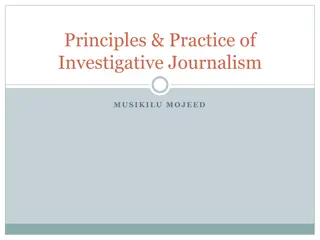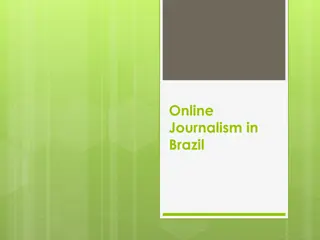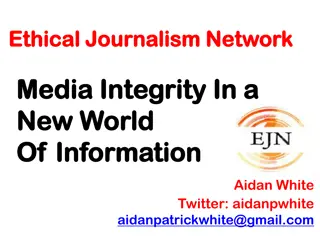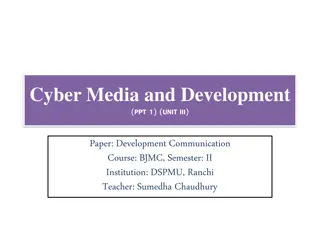Understanding Online Journalism: Definition, Characteristics, and Types
Online journalism encompasses various forms of media based on telecommunication and multimedia, such as websites, online radio, and TV. It involves the convergence of sound, image, and text to provide factual, contextual, and subdivided content. This type of journalism is not confined to news writing but also includes radio and television broadcasts. The characteristics of online media include speed, interactivity, personalization, multimedia elements, and the ability to continuously update information. Different types of online media platforms exist, ranging from news portals and social media to online newspapers and magazines. These platforms adhere to the requirements of the Press Law and the Standards of the Press Company established by the Press Council.
Download Presentation

Please find below an Image/Link to download the presentation.
The content on the website is provided AS IS for your information and personal use only. It may not be sold, licensed, or shared on other websites without obtaining consent from the author. Download presentation by click this link. If you encounter any issues during the download, it is possible that the publisher has removed the file from their server.
E N D
Presentation Transcript
JURNALISME ONLINE Konteks Konteks
JURNALISME ONLINE Konteks Konteks Onno W. Purbo, 1995
JURNALISME ONLINE Pengertian Pengertian Media Daring Media Daring Multifaceted media. It varies from interpersonal to mass communications (Morris as quoted in Surya, 2010). Online journalism is total journalism. Online journalism is the convergence of sound, image, and text. Factual content (sees, hears, reads). Contextual content (asnwers questions about audio video and uses of hyperlink as references to previous and alternate sources). Sub division content (commercial and editorial) (Deuze as quoted in Surya, 2010)
JURNALISME ONLINE Pengertian Pengertian Media Daring Media Daring Media online adalah sebutan umum untuk sebuah bentuk media yang berbasis telekomunikasi dan multimedia (baca-komputer dan internet). Di dalamnya terdapat portal, website (situs web), radio-online, TV-online, pers online, mail online, dan lain-lain dengan karakteristik masing-masing sesuai dengan fasilitas yangmemungkinkan user memanfaatkannya. Praktek jurnalistik tidak sebatas penulisan berita namun juga mencakup isi siaran radio dan televisi. (Ashadi Siregar dalam Kurniawan, sebagaimana dikutip dalam Yusuf, 2010)
JURNALISME ONLINE Pengertian Pengertian Media Daring Media Daring Segala bentuk media yang menggunakan wahana internet dan melaksanakan kegiatan jurnalistik serta memenuhi persyaratan Undang-Undang Pers dan Standar Perusahaan Pers yang ditetapkan Dewan Pers (Pedoman Pemberitaan Media Siber, 2012)
JURNALISME ONLINE Jenis Jenis- -jenis jenis Media Daring Media Daring Portal, website, blog, media sosial, radio onlinr, TV online, email - Edisi online suratkabar atau majalah. - Edisi online penyiaran radio. - Edisi online penyiaran televisi. - Situs berita online yang tidak terkait dengan media cetak atau elektronik. - Situs indeks berita. News organization website, commercial organization website, website pemerintah, website kelompok kepentingan, website organisasi non-profit, personal website (blog). (Romli, 2018)
JURNALISME ONLINE Karakteristik Karakteristik Media Daring Media Daring Kecepatan (aktualitas) informasi Adanya pembaruan (updating) informasi Interaktivitas Personalisasi Kapasitas penyimpanan dapat diperbesar Hyperlink (Ishwara dalam Yusuf, 2010) Multimedia Aktualitas Cepat Pembaruan Kapasitas banyak Fleksibilitas penyuntingan Jangkauan luas (Romli, 2014)
JURNALISME ONLINE Karakteristik Karakteristik Media Daring Media Daring Four Basic Characteristics Speed of feedback (mechanism established in the website to allow interaction with the sender via e-mail, and interactions with other readers via discussion groups or chatrooms). Number and type of sensory channels (how it utilizes multi-sensory capabilities such as visual and audio access to the news as well as the opportunities available to create an attractive means of presenting information in terms of aesthetics and design). The personal address of the source (the use of hyperlinks that can axtend the interaction users have with the message and a search feature that provides the ability to call up news items). Richness and variety in language used. (Elliot as quoted in Surya, 2010)
JURNALISME ONLINE Media Media Baru Baru The defining aspects of the new media are that they are digital, interactive, social, asynchronous asynchronous, multimedia, and narrowcasted narrowcasted. These particular characteristics are important in distinguishing a new, audience-focused conception of the media from the older SMCR model, which emphasized the oneway transmission of messages. (Straubhaar, LaRose, Davenport, 2011)
JURNALISME ONLINE Media Now Media Now Asynchronous Communication Asynchronous Communication. Simultaneity, the notion that everyone in the audience receives the message at about the same time (or synchronously), was once another defining characteristic of the mass media. That view made sense before consumer recording technology became commonplace in the 1960s and 1970s. Before then, you had to catch a program the fi rst time it aired or wait for the reruns. However, the notion never applied very well to fi lm, not without stretching the same time to cover a period of several weeks. Situations that lack simultaneity are examples of asynchronous communication. Consumers ability to time shift programs using Digital Video Recorders (DVRs) and Internet video renders the notion of simultaneity obsolete, as they can choose when to watch a program regardless of the time and day it originally airs. The television networks are now time-shifting themselves by uploading their own programs on the Internet within hours of the time of their original broadcast. Both postal mail and e-mail are two common examples of asynchronous interpersonal communication. (Straubhaar, LaRose, Davenport, 2011)
JURNALISME ONLINE Media Now Media Now Demographic characteristics, such as sex and age, once the sole means of defi ning audiences, are being replaced by lifestyles and user needs, and even individual preferences including purchasing and online surfing behavior. Rather than homogenize audiences, the new communications media cater to specialized groups and define new niches and even customize content for individuals. (Straubhaar, LaRose, Davenport, 2011) Narrowcasting. Narrowcasting. Another sign of the growing power of the audience in the new media is the practice of targeting content to smaller audiences, sometimes called narrowcasting (as opposed to broadcasting). Advanced audience research methods help the media cater to smaller audiences by enhancing the richness and speed of audience feedback. The result is that narrowcasting dedicating communication channels to specific audience subgroups, or market segments is now practical. replaced by a focus on
JURNALISME ONLINE Media Now Media Now Social Media Social Media. Another dimension of audience power in the new media world is the ability of audiences to contribute content of their own, not merely selecting it as in our example of American Idol, but actually creating it themselves. Since this involves sharing words and images with other users in the course of social interactions, social media has emerged as an umbrella term for this phenomenon. Behind the scenes, new technologies have made it possible to strip away the middle layers of media organizations and to shrink the minimum size of media enterprises back to that of small cottage industries and even to individual media entrepreneurs. Giant media corporations are still with us, and indeed they are getting bigger than ever, but the number of people required to turn out a media product within them is shrinking. Affordable TV cameras, audio recorders, and digital editing technology put people from all walks of life in the producer s chair. (Straubhaar, LaRose, Davenport, 2011)
JURNALISME ONLINE Mobile Journalist ( Mobile Journalist (MoJo MoJo) ) From the palm of his or her hand, a reporter can easily gather, produce, and share stories to any platform from nearly anywhere. No need to cart around clunky equipment. Streaming live from the field, for instance, used to require a lot of gear and a small army of people including a reporter, a videographer, and a live truck operator. Now, reporters simply open an app to bring people live to the scene. Mobile devices and apps simplify the process of getting content from the field to the audience, most notably on social media. Not to mention, journalists can engage with followers on the fly. You see, then, why mobile devices and social media go hand in hand. You can t discuss one without the other. Imagine how cumbersome it would be to take photos or record video on traditional devices and then post that content on social media. A single mobile device gives journalists the flexibility to get the job done quickly and efficiently. (Anthony Adornato, 2017)
JURNALISME ONLINE Mobile Journalist ( Mobile Journalist (MoJo MoJo) ) Digital-First Mindset: Mobile and Social First Digital first means mobile and social media first. A digital-first approach requires journalists to use mobile devices to share and engage with audiences on social media prior to publishing on other platforms, such as a website. A news outlet s website is important, of course, but it s increasingly becoming the secondary spot to publish information. It all goes back to the audience s news consumption habits mobile and social. (Anthony Adornato, 2017)
JURNALISME ONLINE Mobile Journalist ( Mobile Journalist (MoJo MoJo) ) Planning Your Story: The Digital-First Story Pitch In newsroom editorial meetings, journalists sell the stories they would like to cover. A story pitch has to be convincing and well thought out. Journalists must be prepared to answer key questions before an editor decides which story they ll be assigned. The art of pitching story ideas takes time to hone. Done right, it can build your credibility and reliability with colleagues as a solid journalist. - - - - - Story focus News peg. Sources. Data/background info. Visuals. (Anthony Adornato, 2017)
JURNALISME ONLINE Mobile Journalist ( Mobile Journalist (MoJo MoJo) ) Different Types of Stories, Different Approaches What you choose from the digital-first toolbox will depend on the type of story you re covering, for instance, a breaking news story versus a feature story. A breaking story will require more frequent posts, and you may choose to stream video live to bring people to the scene. For a feature story, you ll want to post less frequently and might consider crowdsourcing or a live Q&A, approaches that wouldn t work as well in a breaking news situation. The type of story determines the approach, including which channels (Facebook, Twitter, etc.) you ll use. And, in turn, the channel will dictate certain norms, such as the frequency of posts. (Anthony Adornato, 2017)
JURNALISME ONLINE Mobile Journalist ( Mobile Journalist (MoJo MoJo) ) Working Remotely Your office as a journalist is, well, just about anywhere. Odds are you won t be returning to the newsroom to write and file most stories. The news needs to get out now on multiple platforms, and you have the tools do that from the field. Mobile devices allow mojos to be mobile in more than one sense. They give them the flexibility to produce stories with a single device and set-up an office anyplace. (Anthony Adornato, 2017)
JURNALISME ONLINE Mobile Journalist ( Mobile Journalist (MoJo MoJo) ) Equipment and Accessories Before you head into the field, organize the essential equipment and accessories. They can all fit into one backpack a journalist s go-bag. Most newsrooms will issue many of these tools of the trade when you re hired. If you re a freelancer or student journalist, you can build your own toolkit inexpensively. (Anthony Adornato, 2017)
JURNALISME ONLINE Internet of Things Internet of Things Everyone is familiar with the Internet, which connects people to other people (e.g., via email, messaging, or chat or through social networks) and also people to machines to machines (e.g., people to search engines, mapping tools, or movie streaming services). The Internet of Things is the popular term used to add things into this mix, into this mix, and is often intended to encompass not just the things, but the networks, data, and cloud processing that enhance and invigorate them.These can be very small, such as smart dust or nanoparticles, or much larger: light bulbs, thermostats, garage door openers, video cameras, digital signage such as electronic billboards, store shelves, refrigerators, toasters, autonomous robots, driverless cars, farm tractors, buses, planes, jet engines, clothing, cans, bottles, boxes, pallets, air conditioners, washing machines, smart buildings, smart cities, or a smart planet. (Joe Weinman & Fred Wiersema, 2015) people to other people people add things
JURNALISME ONLINE Internet of Things Internet of Things Connected things enable the capture of data on customer behavior that enables intimacy. Smart TVs, set-top boxes, or other streaming devices can capture data on movie watching, gene sequencers or pathology equipment on DNA or tissue samples. Finally, connected things can support innovation can support innovation, by acquiring data by which to gain insight into customer and user needs, behaviors, and contexts that, in turn, can be a first step in creating a commercially viable solution to those needs. (Joe Weinman & Fred Wiersema, 2015)
JURNALISME ONLINE Internet of Things Internet of Things According to Cisco, the number of connected objects is expected to reach 50 billion by 2020, equating to 6.58 connected devices per person. They are all controlled by tiny computers that communicate with each other, in an ecosystem commonly known as the Internet of Things (IoT). The IoT has implications for two distinct aspects of journalism newsgathering and consumption. Smart devices connected to each other can be used to provide better context to a story, such as data on traffic, weather, population density or power consumption. (towcenter.org)
JURNALISME ONLINE Internet of Things Internet of Things (Joe Weinman & Fred Wiersema, 2015)
JURNALISME ONLINE Internet of Things Internet of Things http://ajr.org
JURNALISME ONLINE Internet of Things Internet of Things raspberrypi-spy.co.uk
JURNALISME ONLINE Internet of Things Internet of Things A few ideas for how news organizations can incorporate the Raspberry Pis and sensors into their reporting quickly materialized: We can monitor vibration and noise from entertainment and political venues to identify the most popular songs at a concert, or the biggest plays of a game, or even the quotes that resonate the most at campaign rallies. We can measure water quality in Rio de Janeiro or air quality in Beijing, validating data from environmental protection agencies. More broadly, we can track climate change through conditions of drought or other macro events. We can monitor vibrations to measure the impact of construction sites and how they affect nearby residents and businesses, or foot traffic at new and current public transportation stops to gauge their usage. (towcenter.org)
JURNALISME ONLINE Internet of Things Internet of Things Beyond reporting These new technologies will allow journalists to break more stories and dig deeper into them, further closing the gap between the media and technology industries. It s not just the gathering of news that promises to be affected, though how audiences consume news will also undoubtedly change. Key drivers of the growing Internet of Things are connected cars and smart homes. The experience of talking to a dashboard in your car or asking a device at home to tell you the latest news all depends on personalized voice recognition and natural language processing. As adoption of these smart devices grows, there will still be privacy, security and technical concerns that need to be worked through. The inconsistency of available data in lower population areas also represents a major challenge. But it should be clear by now that the Internet of Things, like the internet in general, won t simply go away. As media companies, we need to start thinking about how these new technologies can help us better inform the world. (towcenter.org)
JURNALISME ONLINE Virtual Reality Virtual Reality It was also during the 1960s that a research student named Ivan Sutherland at the Massachusetts Institute of Technology (MIT) produced a rudimentary form of computer graphics called Sketchpad and a head-mounted display device. Sutherland s prototype graphics system was innovative, exciting and groundbreaking because it indicated the creative potential of computer graphics. Explaining how Sketchpad Sketchpad operated, Howard Rheingold tells us that people could create images in the most natural way possible, by using their hands and eyes and a pen-like device to draw them (1991, 90). Sutherland s early experiments into computer graphics are significant because they provided the foundation for the graphical interfaces that are used for contemporary forms of virtual reality technology. (Melanie Chan, 2014) Ivan Sutherland
JURNALISME ONLINE Virtual Reality Virtual Reality Sutherland s early experiments into computer graphics are significant because they provided the foundation for the graphical interfaces that are used for contemporary forms of virtual reality technology. In 1965 Sutherland presented a research paper entitled The Ultimate Display Display ,hich provided an account of his experimental work on head-mounted displays and virtual reality systems. In this paper, Sutherland discusses the ways in which we perceive and interpret the world around us via the sensory motor capabilities of the human body and our prior knowledge of objects. (Melanie Chan, 2014) The Ultimate
JURNALISME ONLINE Virtual Reality Virtual Reality In The Third Culture, Jaron Lanier (2000) uses the term cybernetic totalists to describe those intellectuals, scientists, researchers and developers who promote the notion of a digital utopia which can be achieved through computing technology. Lanier does not deny that computing and information technology have changed the ways in which we think and communicate; however, he is cautious about claims of universality cautious about claims of universality with respect to computer development. (Melanie Chan, 2014)
JURNALISME ONLINE Daftar Daftar Pustaka Pustaka Quinn, Stephen., Lamble, Stephen. 2007. Online News Gathering: Research and Reporting for Journalism. Elsevier. Hall, Jim. 2001. Online Journalism: A Critical Primer. Pluto Press. Adornato, Anthony. 2018. Mobile and Social Media Journalism: A Practical Guide. SAGE. Jenkins, Henry. 2006. Convergence Culture: Where Old and New Media Collide. New York University Press. Straubhaar, J., LaRose, R., Davenport. 2012. Media Now: Understanding Media, Culture and Technology. 5th Ed. Update. Thomson. Ward, Mike. 2002. Journalism Online. Focal Press. Bradshaw, Paul., Rohumaa, Liisa. 2013. The Online Journalism Handbook: Skills to Survive and Thrive in the Digital Age. Routledge. Tapscott, Don. 2015. The Digital Economy: Rethinking Promise And Peril In The Age Of Networked Intelligence. McGraw Hill. McLuhan, Marshall. 1994. Understanding Media: The Extensions of Man. The MIT Press. Pacey, Arnold. 2000. The Culture of Technology. The MIT Press. Weinman, Joe., Wiersema, Fred. 2015.Digital Disciplines: Attaining market leadership via the cloud, big data, social, mobile, and the internet of things. Wiley. Chan, Melanie. 2014. Virtual Reality: Representations in Contemporary Media. Bloomsbury Academic.





